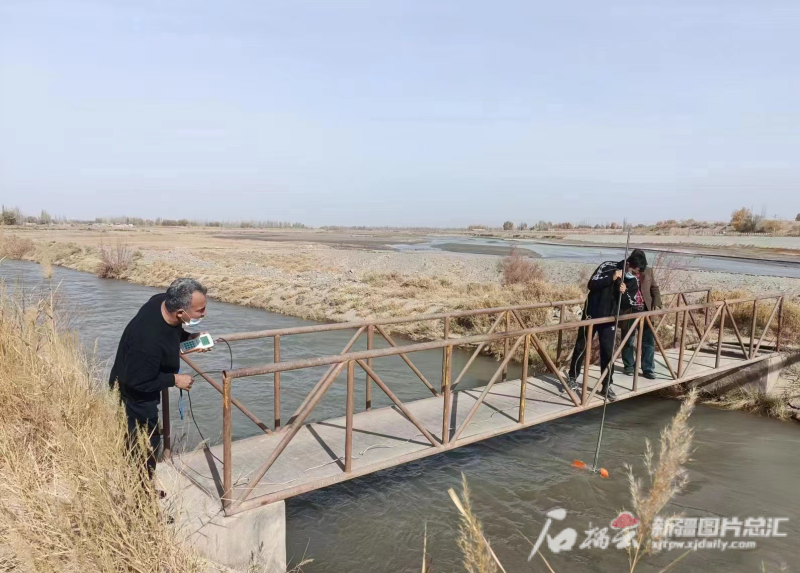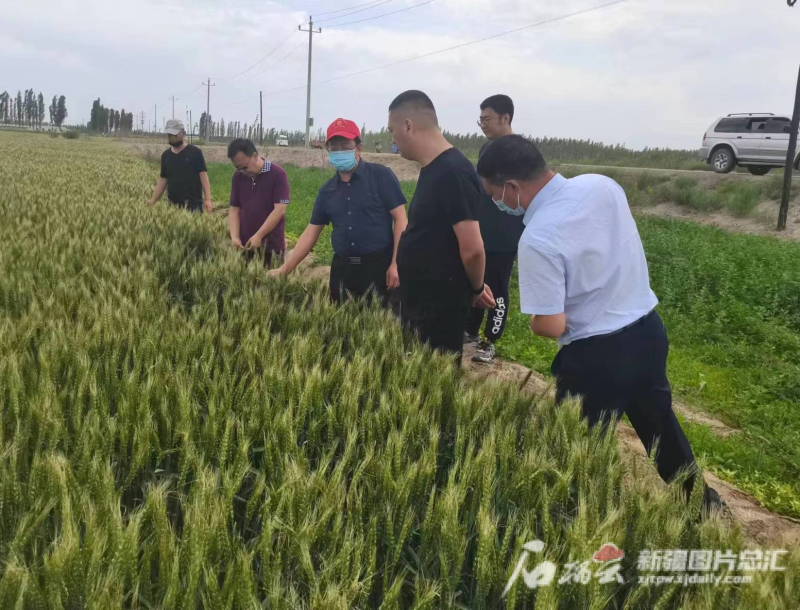Shiliuyun-Xinjiang Daily (Reporter liu Donglai) news: “Look, these frown lines are here because of worrying about water,” said Li Hongyan, pointing his frown with a smile emerging on his face, on November 14, 2022. “This is the first year that I have no worries about water irrigation.”
For this cotton farmer who has 700 mu of cotton fields at Tarim Township in Yuli County, Bayingolin Mongolian Autonomous Prefecture, Xinjiang, water is the topic close to his heart. “I used to worry about water every year. No matter how much water there was in the river, I was given a certain amount of water. But it is different this year, the water supply is particularly adequate,” said Li.

Photo shows in September, 2022, during the flood period, staff members of the Yurungqash River downstream management station of Hotan Administration of the Tarim River Basin and the hydrologic station work together to monitor water levels along water supply channels in real time in order to ensure the water supply of agricultural irrigation in the downstream of the Yurungqash River. (Photo offered by the Tarim River Basin Administration)
Such changes have not only happened to Li, but also many other farmers of the Tarim River Basin, who have never experienced such a big convenience of using water until this year. "As of November 6, 2022, the cumulative agricultural water supply of Aksu River, Hotan River, Yarkant River, Kaidu-Kongque River and the main stream of the Tarim River in the Tarim River Basin (hereinafter referred to as the ‘four sources and one main stream’) was 37.24 million mu times more than that of the same period last year.” Tohut Ahmat, secretary of the Party committee of the Tarim River Basin Administration said, “Contributions may have been made by ‘the help of god’, but ‘human efforts’ are vital to this achievement.”
2022 is a high flow year to most rivers in the Tarim River Basin, as well as a big reform year concerning Xinjiang’s water resource development and usage. In this year, the Party committee of Xinjiang Uygur Autonomous Region pointed out that water is the lifeline of Xinjiang's economic and social development, and further put forward that Xinjiang’s development opportunities depend on the efficiency of water use. Profound changes in the national economic and social water use started in southern Xinjiang.
“In the past, we used to think about the use of water from the perspective of the water conservancy. But since this year, we have changed the course to make the water resources serve the economic and social development more accurately and efficiently,” said Tohut.

Photo taken on May 31, 2022 shows staff members of the Administration of Bayingolin Mongolian Autonomous Prefecture of the Tarim River Basin inspect the irrigation of wheat in Heshuo County, Bayingolin Mongolian Autonomous Prefecture, Xinjiang to implement the requirements of Xinjiang Uygur Autonomous Region on food security. (Photo offered by the Tarim River Basin Administration)
Institutions in the Tarim River Basin have broken the previous water resource quota management mode. Taking water inflow from large rivers as the premise, the demand of irrigated areas has been guaranteed with every effort with accurate and real-time scheduling being implemented, giving full play to the regulating functions of water resources allocation projects such as reservoirs, junctions and sluices, etc. Weekly communication and consultation mechanism has been established. So far, the matching of the spatial-temporal imbalance of water inflow from large rivers with the superposition of water demand in irrigated areas has been effectively solved, and the water supply to irrigated areas comprehensively guaranteed. Adequate agricultural water supply is common in the ‘four sources and one main stream’ area in 2022.
Tohut told the reporter that in 2022, through precise and efficient services, the irrigation demand of all crops at different stages of growth in the ‘four sources and one main stream’ area have been met. The yield of main crops in the area, i.e., wheat, corn and cotton, has increased by 10-30 kg. The growth, quality and fruit bearing rate of melons, vegetables, oil plants and fruits in orchards have also far exceeded those of previous years. “Next, following the guidance of the spirit of the 20th CPC National Congress, we will further enhance our capacity for scientific and overall allocation of water resources and provide a solid guarantee for the high-quality economic and social development of the Tarim River Basin.”
(A written permission shall be obtained for reprinting, excerpting, copying and mirroring of the contents published on this website. Unauthorized aforementioned act shall be deemed an infringement, of which the actor shall be held accountable under the law.)









